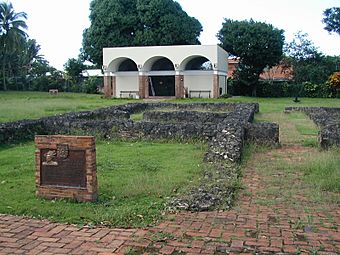Caparra Archaeological Site facts for kids
|
Caparra
|
|

The foundations of the residence of
Juan Ponce de León, c. 1508 |
|
| Location | Guaynabo, Puerto Rico |
|---|---|
| Area | 3 acres (1.2 ha) |
| NRHP reference No. | 84003155 |
Quick facts for kids Significant dates |
|
| Added to NRHP | February 28, 1984 |
| Designated NHL | April 19, 1994 |
Caparra is an archaeological site in Guaynabo, Puerto Rico. It is a very important historical place in northeastern Puerto Rico. In 1994, it was named a U.S. National Historic Landmark. This site holds the remains of the very first European settlement and capital city on the main island of Puerto Rico.
You can still see the foundations of the home of Juan Ponce de León. He was the first European explorer and governor of Puerto Rico. People first settled here in 1508, but the town was officially left empty by 1521. Caparra is the oldest known European settlement in what is now the United States. Today, the site is part of the Museo de la Conquista y Colonización (Museum of the Conquest and Colonization of Puerto Rico). This museum shows old items found at Caparra and other dig sites in Puerto Rico.
Contents
History of Caparra
In 1508, Juan Ponce de León started the first Spanish town in Puerto Rico at Caparra. He named it after an old Roman village called Cáparra in Spain. This Spanish village was the birthplace of Nicolás de Ovando, who was the governor of Spain's Caribbean lands at the time. Today, the area where Caparra once stood is known as the Pueblo Viejo neighborhood of Guaynabo. It is just west of the modern San Juan city area.
Why the Town Moved
The first location of Caparra was not very healthy. People, especially babies, often got sick. Religious leaders asked for the town to be moved closer to the bay and the sea. They thought the Islet of Puerto Rico would be a better spot. This islet reminded them of Gran Canaria in the Canary Islands, which was a good place.
Their wish finally came true after Ponce de León was no longer governor. By 1521, everyone had moved. The new town was called "Villa de Puerto Rico." Over time, the name of the island, San Juan Bautista de Puerto Rico, and the name of the capital city swapped. That is why the capital is now called San Juan.
Ponce de León's Home
Juan Ponce de León built the only stone house in Caparra. For many years, this house was also used as a trading office, a place to keep important records, and a storage for weapons. It became his permanent home, and his family joined him there in 1509.
Discovering Old Caparra
Finding the Site
The Caparra site was first recognized as an important historical place in 1936. This happened during a project to build new places for tourists on the island. Adolfo de Hostos, who was Puerto Rico's official historian, led the first digs in 1936 and 1937.
Uncovering Buildings
During these early excavations, archaeologists found a large structure made of a strong material called tapia. A two-lane road cut right through it. This structure matched descriptions of Ponce de León's own house. His house was the only building in the settlement not made of wood. Further digging helped experts find the main town square and the spots where other buildings once stood.
Protecting the Ruins
The government of Puerto Rico bought the land in 1948. They moved the northern part of the house ruins to make the road wider. In 1963, the road was made even wider, which unfortunately destroyed the southern part of the structure found in 1936. The museum was opened in 1958. Archaeologists continue to study the site today to learn more about Caparra's past.
See also


